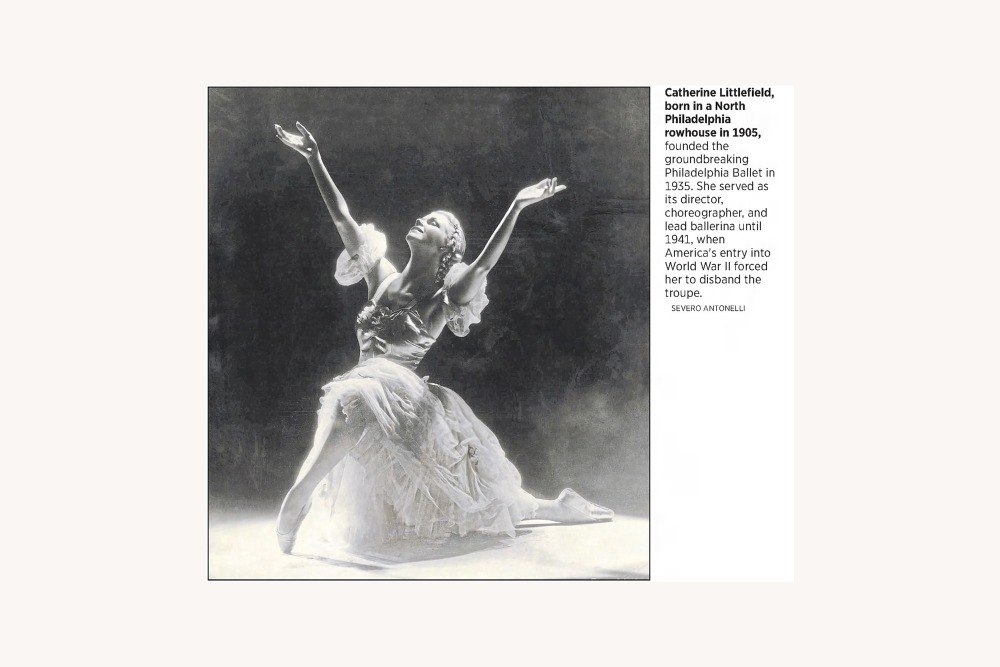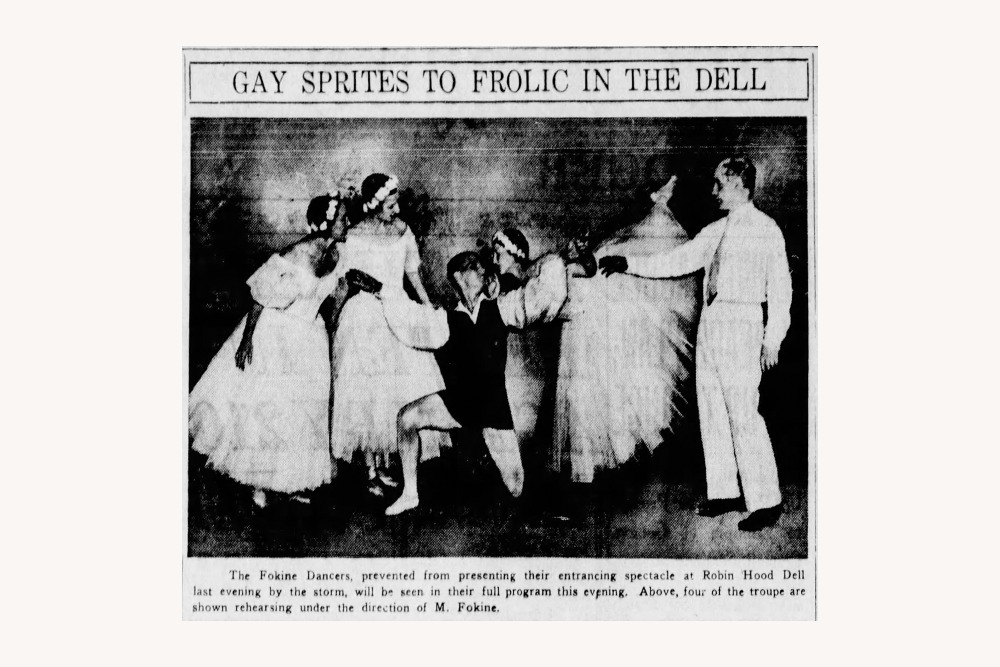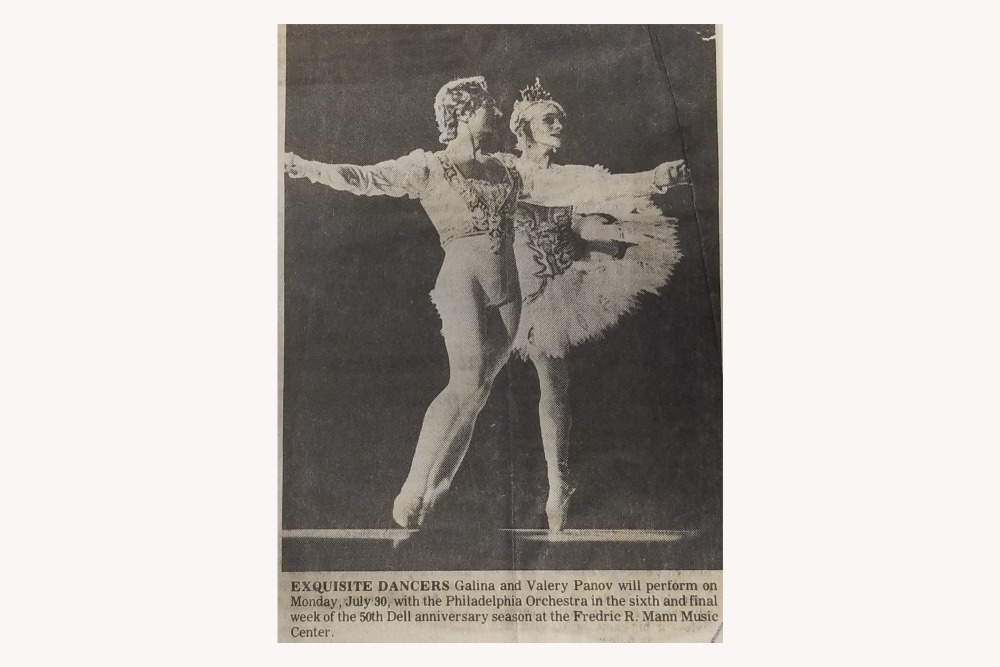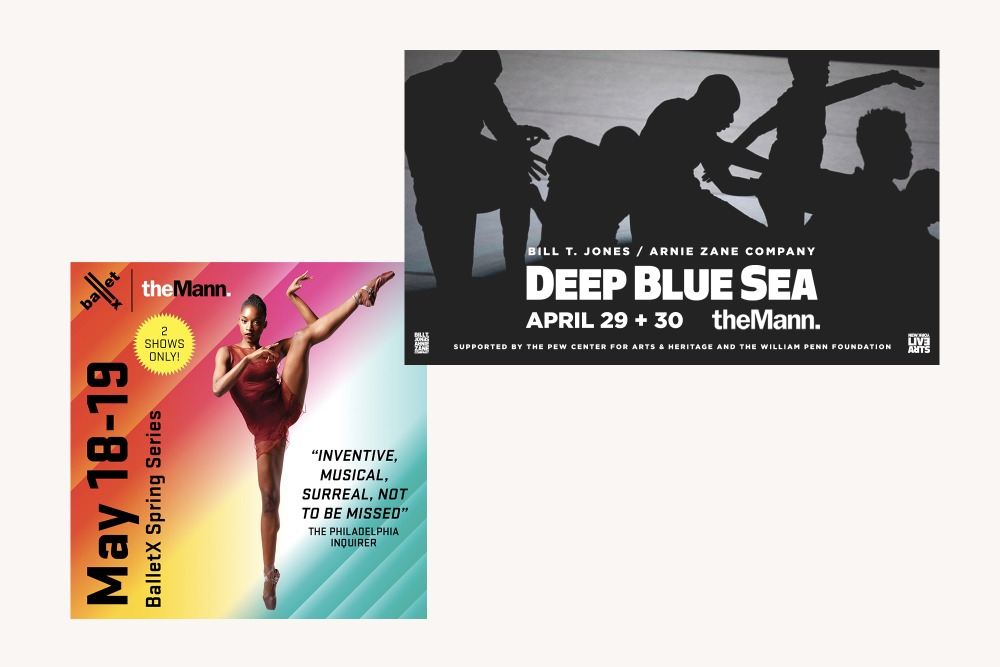From the Vault: Dance at the Mann Center
MANN MUSIC ROOM: VAULT
Blog Entry by Jack McCarthy, Historian, The Mann Center for the Performing Arts
The Mann Center traces its history to the Robin Hood Dell, which opened in 1930 in East Fairmount Park as a summer home for The Philadelphia Orchestra. In 1976 the organization moved to a new venue in West Fairmount Park. Originally called Robin Hood Dell West, it was later renamed the Mann Music Center in honor of its longtime director and benefactor Frederic Mann, and subsequently renamed the Mann Center for the Performing Arts.
Next week, the Mann Center will present Deep Blue Sea, a new dance piece created and directed by acclaimed choreographer Bill T. Jones. Then in May, local company BalletX returns to the Mann, featuring world premieres by Jennifer Archibald and Annabelle Lopez Ochoa as well as one of the company’s signature pieces, The Last Glass, by co-founder Matthew Neenan. These exciting performances are part of an over ninety-year tradition of important dance performances and premieres at the Mann Center and its predecessor, the Robin Hood Dell.
When the Robin Hood Dell opened in 1930, it was intended primarily as a venue for symphonic concerts by The Philadelphia Orchestra, but dance was part of the programing from the beginning. On August 19, 1930, Doris Humphrey, a noted modern dancer and choreographer of the time, premiered her work, La Valse, a ballet set to French composer Maurice Ravel’s well-known piece, at the Dell, accompanied by conductor Alexander Smallens and The Philadelphia Orchestra. Humphrey and her company, the Humphrey-Weidman Group, performed at the Dell four times between 1930 and 1935.
Two local dance troupes led by prominent Philadelphia women also appeared at the Dell in the 1930s: the Littlefield Ballet and the Montgomery Dancers. Catherine Littlefield was an acclaimed dancer, choreographer, and teacher who was a key figure in establishing ballet as an American art form. She formed the Littlefield Ballet in 1934 and later renamed it The Philadelphia Ballet (not to be confused with the current Philadelphia Ballet). The company performed several times at the Dell in the mid-1930s, both as featured artists and as part of larger opera productions. In 1937, Littlefield’s troupe was the first American ballet company to tour Europe. The company disbanded in 1941 when most of its male dancers went into the service in World War II. Mary Binney Montgomery, a friend and colleague of Littlefield’s, was an accomplished concert pianist and dancer who formed a dance company that appeared several times at the Dell in the 1930s. She also ran a dance studio in Philadelphia for many years. Montgomery was born into a prominent Philadelphia family—her father founded what became the Janney Montgomery Scott investment company and her sister was the famous socialite Hope Montgomery Scott, on whom Katherine Hepburn’s character in the popular 1940 movie “The Philadelphia Story” was based.
Other high-profile dancers and ballet companies to appear at the Dell in the 1930s include Ballet Caravan, founded by American writer and impresario Lincoln Kirstein, who would go on to establish several important ballet companies; Fokine Ballet, founded by groundbreaking Russian dancer and choreographer Mikel Fokine, who in the 1910s had been choreographer for the famous Russian troupe, Ballet Russes; and the American Ballet Company, whose choreographer, George Balanchine, had recently emigrated from Russia to the United States and would soon transform American ballet. Balanchine recruited many of the dancers for his first company from the company of his friend, Catherine Littlefield. Ballet Theatre, which was formed in New York City in 1939 and performed at the Dell in 1940 and 1950, also featured three dancers from Littlefield’s Philadelphia Ballet in its early years.
Fokine and Balanchine were the first of many famous Russian dancers and choreographers to appear at the Robin Hood Dell and the Mann Center over the years. Husband and wife duo Valery and Galina Panov were stars of the St. Petersburg-based Kirov Ballet who were persecuted for attempting to leave Russia in the early 1970s. After finally being allowed to emigrate, they were a big hit at the Robin Hood Dell in 1975 and at the Mann Center in 1979, the latter performance drawing an audience of 15,000. The great Mikhail Baryshnikov, who also danced with the Kirov Ballet in his early years before defecting to the West in 1974, appeared at the Mann Center with the American Ballet Theatre and as a featured artist in the late 1970s and early 1980s. The Kirov Ballet itself performed a celebrated four-night series at the Mann in 1986, and the Moscow-based Bolshoi Ballet made its first-ever Philadelphia appearance at the Mann in 2005.
Other international ballet companies to appear at the Dell and Mann over the years include the Royal Danish Ballet in 1957, National Ballet of Canada in 1961, Stuttgart Ballet in 1977, Royal National Ballet of Spain in 1988, Les Ballets Africains in 2004, and England’s Royal Ballet in 2007. In another national dance realm, the popular Irish music and dance show, Riverdance, was featured at the Mann in 1998.
Following in the tradition of Catherine Littlefield and Mary Binney Montgomery, latter-day Philadelphia ballet and dance companies performed at the Dell and Mann in the late twentieth and early twenty-first century as well. Ballet des Jeunes, a local ballet school for young girls, performed at the Dell several times in the 1960s and 1970s, and the Pennsylvania Ballet, founded in 1963 (and renamed the Philadelphia Ballet in 2021), performed annually at the Mann for four years in the mid-1980s. From the world of tap and jazz dance, the African American ensemble, Coppertone Review, led by longtime Philadelphia dancer and choreographer Hortense Allen appeared annually at the Dell in the early 1970s. Contemporary company BalletX debuted at the Mann in 2021 and, as previously noted, will be featured again in May 2022.
Dance has a long, rich tradition at the Robin Hood Dell and Mann Center, indeed.





